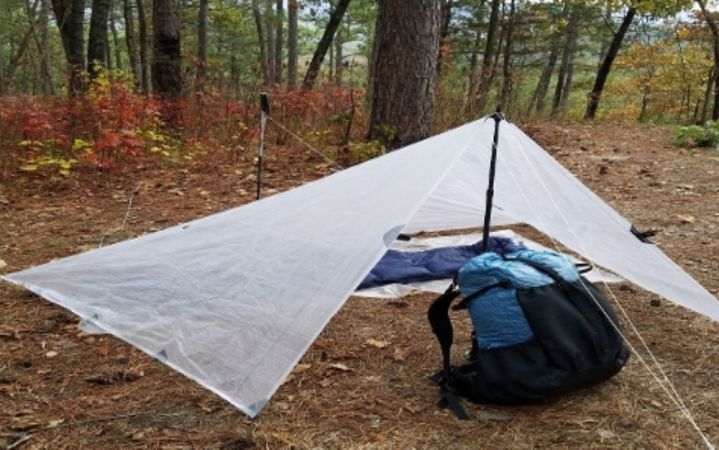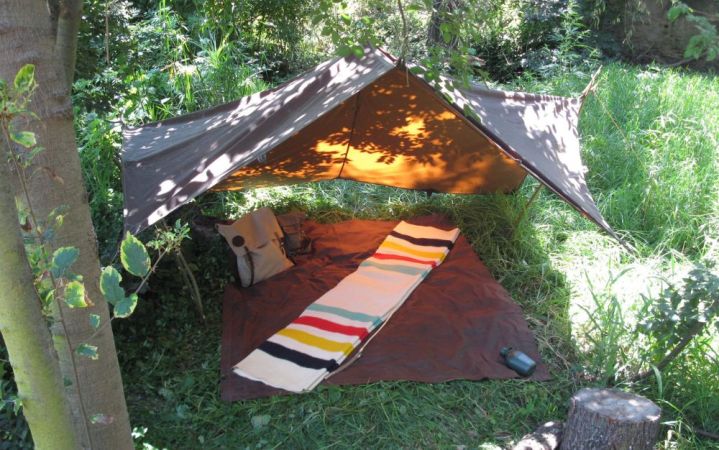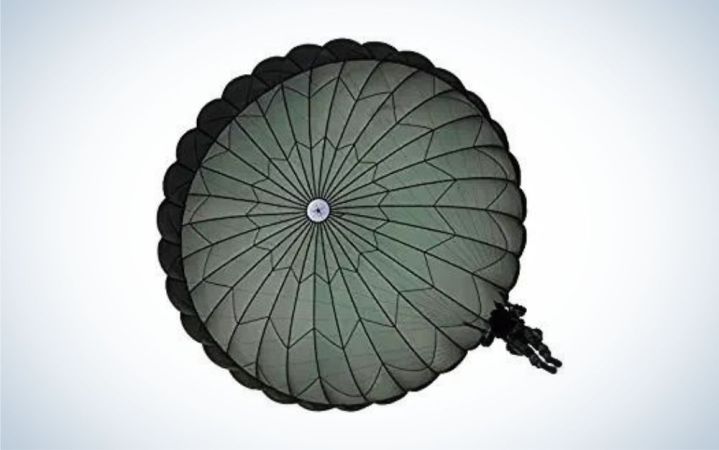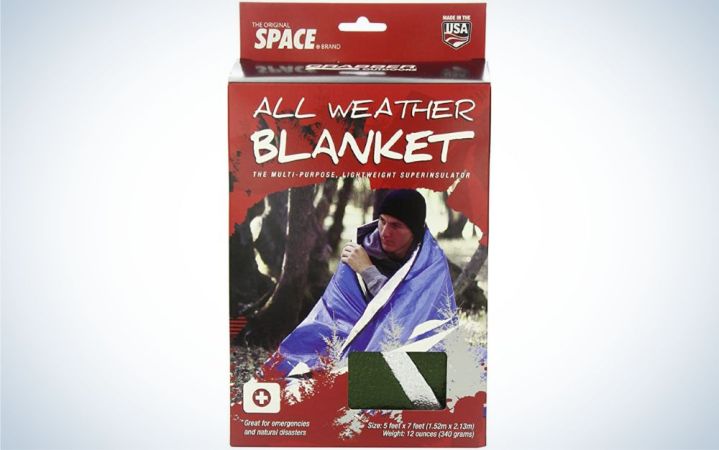We may earn revenue from the products available on this page and participate in affiliate programs. Learn More ›
A simple tarp is one of the most versatile items you can carry into the backcountry. It can be used as a ground or table cloth, a barrier from the sun and wind, a backpack, or in a pinch, as a makeshift rain jacket. A tarp can provide privacy for a primitive shower or latrine, to collect rainwater, or to cover your vehicle’s load on the way into and out of the backcountry. And, of course, it can be used as a shelter.
Tarps are available in a wide range of sizes, weights, and materials. Handy features like grommets or cloth tie-down tabs add functionality for a wide variety of field purposes, and smart buyers will also consider shape, whether rectangular, square, or asymmetrical.
All those features and functions should expand your expectation of a tarp, and change your primary question from “should I own a tarp?” to “which tarp should I own?” That’s where my review of the best camping tarps should help you.
- Best Backcountry: Kifaru Sheep Tarp
- Best Living Space: Litefighter Commando Field Tarp
- Best General Purpose: Etowah Tarp
- Best Budget Tarp: Generic Blue Tarp
- Most Durable: OilCloth Tarp
- Best Lightweight: Hyperlite Mountain Gear Ultralight Flat Tarp
- Best Repurposed Tarp: Surplus Military Parachute/Canopy
- Best Hammock: Dutchware Gear Ultralight Xenon Hex Tarp
- Best Bushcraft Tarp: MSS Multipurpose Survival Shelter
- Best Emergency: Sportsman’s Blanket
How to Choose a Camping Tarp
In order to select the best tarp for your needs, consider both your budget and the features you require. Basic tarps won’t break many budgets, but as you add key features and materials, prices increase. Consider square footage, too. For an emergency shelter for a single person, a smaller rectangular tarp that can also double as an emergency camping blanket pitched low to the ground makes sense. For a shelter used to support a larger group, a much larger square tarp pitched high will provide more room to cook the best camping meals, hang out, and store your gear. Consider how the tarp will be supported and where it will be pitched in order to determine the best design and fabric.
Traveling deep in the mountains? Lightweight nylon is your best option. Setting up a deep-woods canoe camp? A heavier, abrasion-resistant tarp is the better option. Keep in mind, though, added durability also adds weight.
Once you consider price, size, and material, look at smaller features that can make or break a design. Where are tie-down tabs, and are there places to attach guy-out lines for additional security. Can the tarp work with a support, such as a trekking pole? Or do you simply need a bombproof, simple tarp?
Best Backcountry: Kifaru Sheep Tarp
Best Backcountry
Key Features
- Weight: 9 ounces (canopy only)
- Dimensions: 9 feet x 5 feet
- Sleeps one person plus gear
- Made in U.S.
Why It Made the Cut
The Kifaru Sheep Tarp is designed as an emergency backcountry shelter for high-altitude hunting trips where ounces matter. The Sheep Tarp can fit inside a pants pocket and even though the tarp comes with a stuff sack, it can be compressed into a much smaller package for toting into the backcountry. It works as an ultralight tent, emergency shelter, and even a makeshift poncho draped over the body in a sudden rainstorm.
Pros
- Lightweight and highly compressible
- Multiple tie-down points
- Extremely versatile
Cons
- Questionable durability
- Relatively expensive
- Would benefit from seam coating
Product Description
The Kifaru Sheep Tarp weighs only nine ounces but is capable of withstanding winds to 60 mph. It measures nearly 5 feet x 10 feet and is the perfect size for protecting one person and their gear. Constructed of lightweight nylon, it has 14 tie-down points for various configurations and can compress down even further for packability, folding to fit in the sleeve of a pack’s hydration bladder. Mid-body tie-out tabs can convert the tarp to a lean-to.
Best Living Space: Litefighter Commando Field Tarp
Best Living Space
Key Features
- Dimensions: 10 feet x10 feet
- Includes field repair kit, six ground stakes, and carry bag
- 25 configurations
- Weight: 2.1 pounds
Why It Made the Cut
There is a difference between living space and sleeping space. The Litefighter Commando Field Tarp can convert into a covert shelter for both purposes. The tarp is printed with OCP (Operational Camouflage Pattern), made entirely in the United States, and is configurable in 25 different ways. It’s perfect for suspending high above your head to protect an outdoor kitchen or gear storage. In a pinch, it can be lowered and set up as a group shelter for up to three or even four occupants.
Pros
- Durable
- Camouflage blends into surroundings
- Veteran-owned business
Cons
- Premium price for attributes
- Not available in non-camo colors
Product Description
The Litefighter Commando Field Tarp measures 100 square feet (10×10) and stuffs down to 5x5x12-inch cube. It weighs 2.1 pounds and includes six aluminum stakes. The tarp includes printed set-up instructions on water-resistant fabric on the outside of the stuff sack. An additional value, the tarp includes guy lines with polymer line-tensioner devices. One of the best ways to use this tarp for discreet camping is using it like a tube tent with material both below and above you. If you use this tarp this way, take the time to coat it with permethrin to keep the bugs from crawling inside. The Commando Field Tarp comes with textured cording that is easy to grasp with cold or wet hands.
Best General Purpose: Etowah Tarp
Best General Purpose
Key Features
- 1.9 ounce nylon ripstop
- Weight: two pounds
- Size: 10 feet x10 feet
- Made in U.S.
Why It Made the Cut
The Etowah urethane-coated nylon coyote-tan tarp is perhaps the best general-purpose tarp on the market. The color is neutral, the 1.9-ounce fabric is neither too heavy nor too flimsy, and the company has a long history of tarp-making. This economical tarp can be used for everything from bushcraft shelters to sunshade on the beach and anything else you might use a tarp for.
Pros
- Multiple colors available
- Priced competitively
Cons
- Seams need sealing
- Questionable durability
Product Description
The Etowah 1.9-ounce urethane-coated nylon tarp measures just over 100 square feet and weighs two pounds. The tarp, which ships in a simple stuff sack, has webbing tabs that are evenly spaced to allow the user to configure it in many different setups. One of the best ways to rig this tarp is with prestaged prusik loops on the tie-down tabs and with dedicated paracord on the ridgeline. Both make for quick setup and breakdown and allow you to keep the tarp suspended off the ground as you secure the additional corner tie-down lines.
Best Budget Tarp: Generic Blue Tarp
Best Budget Tarp
Key Features
- Woven polyethylene fibers
- Weight: 1.4 pounds
- Dimensions: 8 feet x10 feet
- Aluminum grommets
Why It Made the Cut
This tarp won’t win any beauty contests or stir the hearts of those who dream of camping under canvas. It will, however, protect your wallet, and it won’t break your heart if you have to toss it at the end of a trip. The generic blue tarp is my choice for both the most economical and the most visible tarps in our roundup. The signature blue color of this more or less disposable tarp is highly visible against green forests or brown terrain.
Pros
- Low cost
- High visibility
- Economical
Cons
- Lacks durability
- Grommets are not easily repaired in the field
Product Description
These tarps vary in size, weight, and material. They are widely available in most hardware and big-box stores and they can be replaced easily. Among their leading attributes: they’re highly visible, so much so that skydivers will often use these tarps to mark dropzones. Pack one in your emergency kit to help you get found. But you should also pack a roll of duct tape to repair the relatively fragile material.
Most Durable: OilCloth Tarp
Most Durable
Key Features
- Oil-and wax-finished long staple cotton
- Weight: 5.8 pounds (for 10-foot x 9-foot version)
- Custom dimensions
Why It Made the Cut This canvas tarp speaks to the inner frontiersmen in all of us. The oilskin material is heavy but hard-wearing and is perfect for a frontier-style camp or any other use where weight is not a prime consideration. This is the tarp we’d be comfortable throwing in the back of an ATV or strapping it to a horse. Made from 6.25-ounce-per-yard canvas, it’s nearly three times as heavy as many other tarps in this roundup. Oilskin tarps give off different vibes than nylon tarps and the sensation of camping underneath connects you with outdoorsfolk of decades and even centuries past.
Pros
- Extremely Durable
- Traditional look/design
Cons
- Weight
- Packability
Product Description
The Tentsmiths Oilskin tarp is available in various sizes ranging from 7 feet x 7 feet all the way up to 15 feet x 15 feet. The tarp features multiple tie-down loops as well as a single centrally located heavily reinforced tie out if the tarp is used in a diamond set up. Tentsmith also offers traditional stakes, stuff sacks, and a tarred bank line to complete the vintage look. Smaller versions of this tarp can double as a gear roll. Fold it into a smaller rectangle and place your gear or blanket in the middle. Roll it up and tie it off on both ends with cordage. The roll will fit underneath your arm and secure your kit as you wander the woods like woodsmen of the past.
Best Lightweight: Hyperlite Mountain Gear Ultralight Flat Tarp
Best Lightweight
Key Features
- Weight: .61 pounds (8 feet x10 feet)
- Material: DCF8
- Dimensions: 8 feet x 8 feet or 8 feet x10 feet
Why It Made the Cut
The ultralight backpacking community knows ounces turn to pounds the further you get down the trail. For those who are looking for the utility of a tarp but don’t want to carry the weight, the Hyperlite Mountain Gear Dyneema Flat Tarp should be your choice. This tarp is commonly used for shelters where trekking poles are used to prop up the ends for more living space. Dyneema is the industry standard for ultralight fabric used in the backpacking community. This tarp is large enough for a pair of backpackers who can trade off carrying it to and from the trailhead.
Pros
- Extremely lightweight
- Extremely packable
Cons
- Most expensive tarp featured
- Limited color choice
Product Description
The Hyperlite Mountain Gear Flat Tarp is available in two sizes—8 feet 6 inches x 8 feet 6 inches and 8 feet x 10 feet—for different setup options. The tarp has fully bonded seams and excellent UV resistance. Additionally, the Flat Tarp has flat edges and square corners that boosts its strength. The tarp weighs 8.85 ounces and 9.74 ounces respectively. These tarps are extremely lightweight but you must take care not to damage them. They work really well in conjunction with bivy sacks and other small shelters to provide additional wind protection. That said, in high winds, lower your tarp as much as possible to prevent the fragile fabric from becoming too stressed.
Best Repurposed Tarp: Surplus Military Parachute/Canopy
Best Repurposed Tarp
Key Features
- Affordable
- Reduces waste
- Packable
Why It Made the Cut
There are many bushcraft and survival schools that utilize repurposed military parachutes for group shelters. They are as common as firesteels and metal canteen cups in that outdoor circle. Military parachutes are constructed of sil nylon and they are easily cut to size and used for covering primitive shelters. I like the idea of using these parachutes given the packability of the fabric and the pre-attached lines that are made from stout 550 parachute cord.
Pros
- Budget Sil nylon “tarp”
- Large size for area shelters
Cons
- Inconsistent quality
- Variable availability
Product Description
Military surplus parachutes vary in size and shape and make some of the best camping tarps. They also come in various conditions from new to very used. Some parachutes come with 550 paracord lines attached while others may have missing components. Color will vary as well as price. When you purchase a military parachute, don’t be afraid to trim it to size, remove any hardware that adds unnecessary weight, and manage your expectations that it will be entirely water resistant. Most canopies have an opening in the center making them excellent for heated tipi construction but the fabric isn’t seam sealed for shedding water. If necessary, you can double a military parachute for additional water resistance or you can double the fabric in the desert to create dead-air space that will help cool you in the scorching sun.
Best Hammock: Dutchware Gear Ultralight Xenon Hex Tarp
Best Hammock
Key Features
- Weight: About half a pound (11-foot model)
- Dimensions: 11 feet x 9.5 feet or 12 feet x 9.5 feet
- Material: Xenon Sil nylon
Why It Made the Cut
Most tarps can be pressed into service for hammock camping, but a dedicated hammock camping tarp like the Dutchware Gear Ultralight Xenon Hex Tarp will prove superior in the task it was designed for. Hammocks may span great distances between trees and this usually requires taking a square shape and using it on the diagonal. This tarp provides side coverage to block the wind that can affect your sleep comfort in colder weather. Constructed from .9 oz nylon that will make weight-conscious campers happy, it’s the ideal tarp to convert to a hammock.
Pros
- Excellent coverage for hammock campers
- Multiple custom options
Cons
- Lacks mid-body tie out points
- Price increases quickly with multiple custom options
Product Description
This tarp makes one of the best hammocks for camping, and it has a non-standard shape. It is available in either 11- or 12-foot lengths. Numerous color options are available on the Dutchware Gear website, where you can build your custom model. The tarp weighs .69 or .73 pounds, depending on the length selected. Gear organization in a hammock is different than in a tent. Since you may use the same ridgeline to support your tarp as you do for hanging your boots, headlamp, and other kit, tie a strong ridgeline with a trucker’s hitch or use the Dutchware Gear line tensioners to prevent your ridgeline from sagging.
Best Bushcraft Tarp: MSS Multipurpose Survival Shelter
Best Bushcraft Tarp
Key Features
- Dimensions: 5 feet x 8 feet
- Weight: 1.25 pounds
- Material: 1.9 ounces urethane-coated nylon
Why It Made the Cut
The MSS Multipurpose Survival Shelter is the ideal bushcraft tarp for those outdoorsfolk who want to sleep in the open air. The interesting feature of the MSS is the addition of side flaps to close off the shelter when configured as a lean-to. The MSS comes with an attached stuff sack for packability and protection when not in use. This model combines durability with practicality and the colors don’t call attention to your shelter location. Perhaps the coolest (or should I say warmest?) thing about this shelter is that it’s designed to be used with clear plastic for a “super shelter” in winter conditions.
Pros
- Dedicated design for lean-to use
- Intuitive wing setup
Cons
- Size limits accommodates one comfortably
- Flaps can be excessive when not in use
Product Description
This tarp measures 5 feet x 8 feet and packs down to the size of a standard poncho. The fabric is 1.9-ounce polyurethane-coated nylon and the tie outs are double bar-tacked for extra strength. The tarp weighs only 17 ounces and has plenty of tie downs along the body and side triangles for pitching. While designed to be a lean-to, it can be pitched as a low-hanging A-frame as well. It’s also designed to be used as a winter-weather “super shelter.”
Best Emergency: Sportsman’s Blanket
Best Emergency
Key Features
- Weight: 12 ounces
- Dimensions: 5 feet x 7 feet
- Materials: Laminate of fiber scrim and aluminized plastic
Why It Made the Cut
These emergency Sportsman’s Blankets have been around for decades. I’ve owned a few and used them for many different camp purposes; they’re the happy child from the marriage of a standard blue tarp and an emergency blanket. I like that this tarp has a reflective side for emergency signaling and to reflect body heat. I also like that this tarp can be just as easily used as a ground cloth as it can be a cover over your head; its grommets allow it to be pressed into service in many ways.
Pros
- Multiple uses
- Inexpensive and reusable over and over
Cons
- Grommet durability
- Small dimensions for true emergency shelter use
Product Description
Measuring 7 feet x 5 feet, this blanket is made by the Grabber company, the original manufacturer of the SPACE blanket brand. The tarp weighs .81 pounds and comes in various colors including red, blue, orange, and green. The Sportsman’s Blanket features metal grommets for tying down or for securing ends shut. One of the most impressive uses for this emergency blanket is the trapping of heat from a fire that warms not only your front but your back, with its reflective surface.
FAQs
Camping tarps cost anywhere from around $20 to over $700. The cost depends on the materials and size of the materials used.
When choosing a tarp size for camping you’ll want to consider things like size, weight, and materials. You’ll want to make sure the size of your tarp adequately covers your desired area, especially if you’re using it as a shelter. And if you’re hiking or camping in the backcountry, you’ll want to consider how much weight it adds to your pack, as well as the kind of conditions you might encounter.
Absolutely, camping tarps are worth it, especially when you consider their versatility and availability. If you like getting great economy out of all your gear, most camping tarps, unlike some of the best tents for camping, can easily go from your shelter to an emergency blanket in a flash.
Methodology
I considered all these tarps from multiple perspectives ranging from backpacker, weekend camper, seasoned bushcrafter/survival skills practitioner, and general use. The focus of my evaluation was shelter size, weight, durability, multi-purpose use, and affordability. I selected tarps for their popularity within various communities including hammock campers, do-it-yourselfers, military, and backcountry campers. I measured each tarp against the specifications of its peers to determine my top picks.
Final Thoughts
There are many tarps on the market, and because of their wide versatility, you should carry one for the same reason you carry a Swiss Army knife or duct tape: you never know when it will come in handy. You don’t have to settle for using the same tarp for every application and you may find owning a few of the best camping tarps provides you the most versatility for creating shelters in conditions that range from extreme heat, wet weather, or a simple sunshade for your family/pets. Tarp technology continues to improve but the idea behind this most basic type of gear remains as it has been for centuries: simple versatility.













